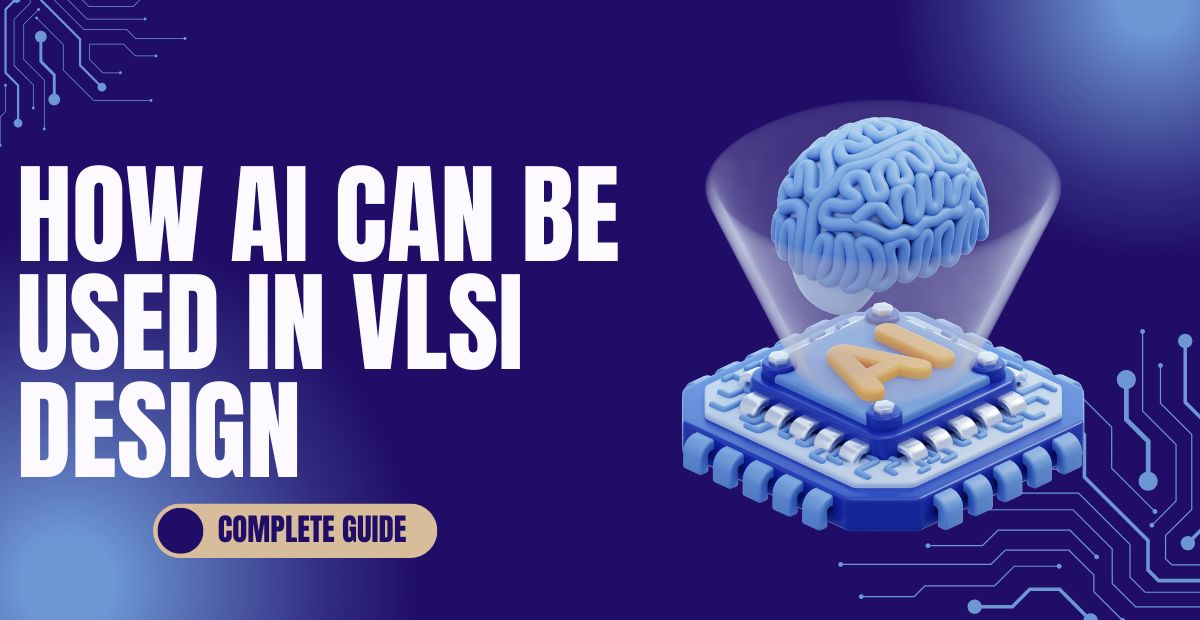Introduction
The semiconductor industry is undergoing a massive transformation with the integration of AI in VLSI design. AI is transforming the design, verification, manufacturing, and testing of chips, resulting in faster, more cost-effective, and more efficient processes.
With the increasing complexity of modern chips (such as 5nm, 3nm, and below), traditional Electronic Design Automation (EDA) tools struggle to keep up. AI-powered solutions are stepping in to optimize design flows, predict failures, and enhance performance.
Understanding VLSI and AI
What is VLSI?
VLSI (Very-Large-Scale Integration) is the process of embedding millions (or billions) of transistors onto a single chip. It involves:
- Front-end design (RTL coding, verification, synthesis)
- Back-end design (floorplanning, placement, routing)
- Manufacturing and testing
What is AI?
AI is the term for machines that simulate human intelligence. Key AI techniques include:
- Machine Learning (ML): Algorithms learn from data.
- Deep Learning (DL): Neural networks for complex pattern recognition.
- Reinforcement Learning (RL): AI learns by trial and error.
The Intersection of AI and VLSI
AI helps automate and optimize VLSI design by:
- Reducing human effort in debugging and verification.
- Predicting chip failures before fabrication.
- Accelerating time-to-market.
Applications of AI in VLSI Design
AI in RTL Design and Verification
- Automated Bug Detection: AI models analyze RTL code to predict bugs.
- Formal Verification: AI improves theorem proving and equivalence checking.
- High-Level Synthesis (HLS): AI optimizes C-to-RTL conversion.
AI in Physical Design and Layout Optimization
- Floorplanning: AI predicts optimal component placement (e.g., Google’s AI-generated floorplans).
- Routing Optimization: AI reduces wirelength and congestion.
- Lithography Optimization: AI enhances photomask design for smaller nodes.
AI in Power and Thermal Management
- AI forecasts power requirements with Dynamic Voltage and Frequency Scaling (DVFS).
- Thermal Simulation: AI models heat distribution to prevent hotspots.
AI in Testing and Yield Prediction
- Defect Localization: AI identifies faulty transistors.
- Predictive Yield Modeling: AI forecasts manufacturing defects.
AI in Security and Hardware Trojans Detection
- Anomaly Detection: AI spots malicious circuit modifications.
- Side-Channel Attack Prevention: AI detects power/EM leakage patterns.
Key AI Techniques Used in VLSI
| AI Technique | Use Case in VLSI |
| Machine Learning (ML) | Predictive modeling for yield optimization |
| Deep Learning (DL) | Image recognition for defect detection |
| Reinforcement Learning (RL) | Autonomous chip floorplanning |
| GANs | Synthetic data generation for testing |
| Evolutionary Algorithms | Analog circuit optimization |
AI Tools and Frameworks for VLSI
Commercial AI Tools
- Cadence Cerebrus: AI-driven chip optimization.
- Synopsys DSO.ai: Autonomous design space exploration.
- Mentor (Siemens) Solido: AI-based variation-aware design.
Open-Source AI Tools
- TensorFlow / PyTorch: Custom AI models for VLSI.
- OpenROAD: AI-integrated RTL-to-GDS flow.
Custom AI Solutions
In-house AI models for proprietary optimization.
Challenges and Limitations of AI in VLSI
- Data Dependency: AI needs large, high-quality datasets.
- Computational Cost: Training AI models requires high-performance computing.
- Interpretability: Black-box AI decisions can be hard to trust.
- EDA Integration: Merging AI with traditional tools is complex.
Future Trends of AI in VLSI
- Autonomous Chip Design: AI designing chips without human intervention.
- AI-Driven EDA Tools: Fully automated design flows.
- Neuromorphic Computing: Brain-inspired AI chips.
- Quantum AI in VLSI: Quantum machine learning for optimization.
Case Studies
Google’s AI for Chip Floorplanning
- Used RL to design TPU chips faster than humans.
- Reduced design time from weeks to hours.
NVIDIA’s AI-Based Verification
- AI reduced verification time by 30%.
Samsung’s AI for Semiconductor Manufacturing
- AI improved defect detection accuracy by 40%.
How to Get Started with AI in VLSI
Learning Resources
- Books: “AI for VLSI” by Saraju Mohanty
- Courses: Coursera’s “Machine Learning for VLSI”
- Certifications: Cadence/Synopsys AI training
Practical Steps
- Learn Python and ML frameworks (TensorFlow, PyTorch).
- Experiment with open-source EDA tools.
- Implement AI models for small VLSI tasks.
Conclusion
AI is transforming VLSI design, making it faster, smarter, and more efficient. From automated verification to AI-driven manufacturing, the future of semiconductors lies in intelligent automation.
By leveraging AI, engineers can overcome Moore’s Law limitations and push the boundaries of chip design.
Frequently Asked Questions (FAQs) on AI in VLSI
Can AI completely replace human VLSI engineers?
No, AI is a tool that augments human expertise rather than replacing it. While AI automates repetitive tasks (like verification, layout optimization, and bug detection)
human engineers are still needed for:
- Creative problem-solving (architectural decisions).
- Interpreting AI suggestions (AI may generate false positives).
- Ethical and strategic decision-making (e.g., trade-offs between power, performance, and area).
Which AI techniques are most useful in VLSI design?
- Supervised Learning (for defect classification, yield prediction).
- Reinforcement Learning (RL) (for autonomous floorplanning, Google’s TPU case study).
- Generative Adversarial Networks (GANs) (for synthetic data generation in testing).
- Graph Neural Networks (GNNs) (for circuit netlist optimization).
What programming languages should I learn for AI in VLSI?
For VLSI Design: Verilog/VHDL (RTL), SystemVerilog (verification).
For Scripting: Tcl (EDA tool automation), Perl/Bash (pre-processing data).
How does AI improve chip manufacturing yield?
- Analyzing historical fab data to identify failure patterns.
- Optimizing lithography masks for advanced nodes (3nm, 2nm).
- Enabling real-time adjustments in wafer fabrication (e.g., Samsung’s AI-powered fabs).
Are there open-source AI tools for VLSI?
- OpenROAD (AI-integrated RTL-to-GDS flow).
- Qflow (Automated digital design with ML-based optimization).
- TensorFlow/PyTorch (Custom AI models for VLSI tasks).
What are the biggest challenges of using AI in VLSI?
- Data Scarcity: High-quality training datasets are hard to obtain.
- Computational Costs: Training AI models requires massive GPU/TPU resources.
- Black-Box Nature: Engineers may distrust AI’s unexplained decisions.
- EDA Tool Integration: Legacy tools may not support AI plugins.
How is AI used in VLSI verification?
- Automating test case generation (e.g., NVIDIA’s AI-based verification).
- Predicting simulation failures before full runs.
- Reducing coverage holes via intelligent stimulus generation.
Can AI help reduce power consumption in chips?
- Dynamic Voltage Scaling (DVS): AI predicts workload demands.
- Clock Gating Optimization: ML identifies idle circuits to power down.
- Thermal Management: AI prevents hotspots through predictive cooling.
What’s the future of AI in VLSI?
- Self-designing chips (AI-driven autonomous design).
- AI-EDA hybrids (e.g., Synopsys DSO.ai, Cadence Cerebrus).
- Neuromorphic chips (AI hardware mimicking the human brain).
Where can I learn AI for VLSI?
- Coursera: “Machine Learning for VLSI”
- Udemy: “AI/ML for Semiconductor Engineers”
Books:
- “Artificial Intelligence for VLSI” by Saraju Mohanty.
- Elfadel, Ibrahim Abe M. “Machine Learning in VLSI Computer-Aided Design.”
Are you interested in learning more about AI in VLSI? For the most recent information and developments in AI-powered chip design, keep checking back with Infinity Logic!





